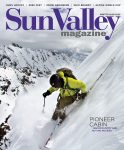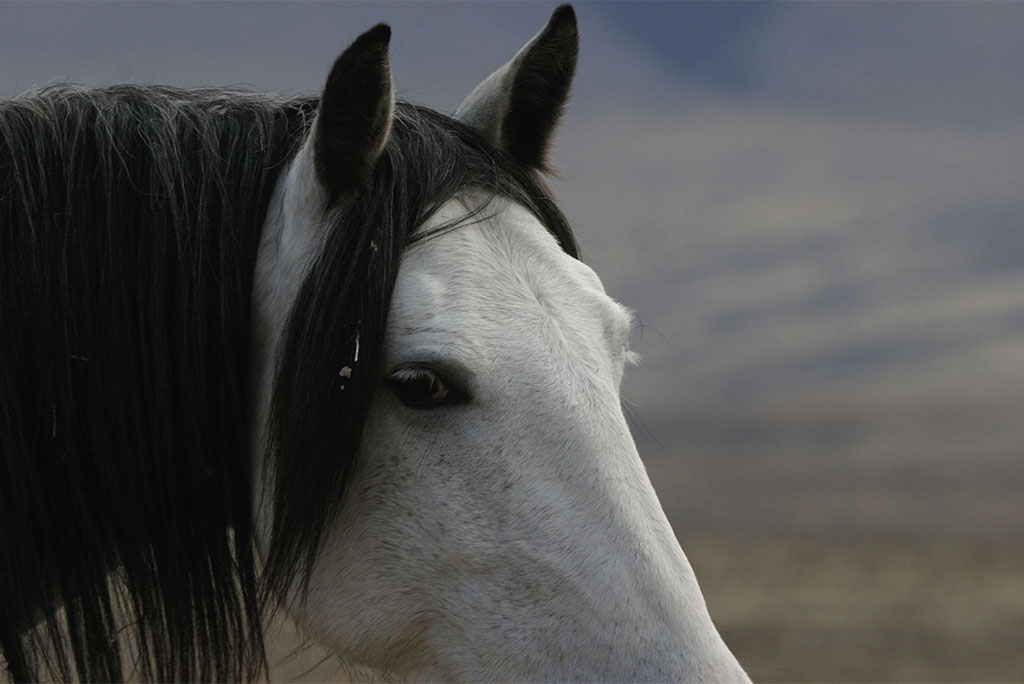In the rugged wilderness of Central Idaho, where the horizon stretches upwards into the endless blue and the scent of sagebrush hangs in the air, photographer Elissa Kline found herself immersed in a story of resilience and connection with a band of the Challis Wild Horses. It’s a tale that intertwines with her journey, weaving together moments of sorrow, inspiration, and the enduring spirit of freedom.
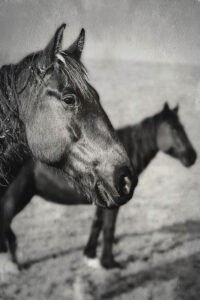
The written history of Idaho’s wild horses dates to 1805, when journal entries from the Lewis and Clark expedition noted that they observed at least 700 horses with the Native Americans in the Lemhi Valley.
Kline first arrived at the edges of the Challis wild horse story as a favor for a friend—writer Bonnie Garman had asked her to take pictures in 2004 after witnessing a Bureau of Land Management (BLM) roundup and seeing the effect it had on the bands of family groups. It began as a documentary collaboration simply to capture the family units Garman had been observing near her ranch outside Challis, but it grew into something much more profound for Kline in the ensuing years. That collaboration resulted in Kline’s hauntingly beautiful images accompanying Garman’s groundbreaking article “Mountain Mustangs” in the Winter 2007 issue of Sun Valley Magazine:
The most wary wild horses have hidden out in these hills for generations, breeding and forming their own bands, and these are the horses I have been tracking on the trails and in the hills surrounding our ranch.
I have watched the Challis herds for many years. I move slowly, I must be patient. I’ve learned to read the movement of the horses, keeping my scent downwind. In the wild and during roundups, I have witnessed births and deaths, changing of the guard, fierce competition, blinding fear and loyal fury. What I have learned—and likewise supported through others’ research—is that wild horses emote. They love, they fear, they have a sense of humor and they mourn. They are loyal, follow rules and take time out to play.
The bands resemble a tight family unit. The stallion is the protector of that unit. He wards off mountain lions, wolves and other physical threats, including man. Once established—through bloody battles with the other males in the herd—the lead stallion will never leave his herd unless he becomes incapacitated or too old to take care of them. There will come a time when a younger or more powerful stallion will drive him away, taking over his mares and offspring.
If they survive the harsh winters, the mares begin foaling in early spring. They hold out—if they can—until nightfall so they have the added protection of darkness.
Mares who can’t care for their young, or who die while birthing, are dutifully replaced by another mare. They work together teaching the foals discipline, respect and the ways of their ancestors. The old mares know the ancient trails to high, spring-fed pastures in summer and the sheltered arroyos and canyons in the harshness of winter. They work together in disciplined order. This deep family connection is one of the reasons the roundups are so hard on the herd.
– Bonnie Garman, 2007
It has been nearly two decades since Garman and Kline brought the story of Idaho’s wild horses vividly to life on the pages of Sun Valley Magazine. The journey of the Challis Wild Horses is a timeline marked by both adversity and triumph. As the years passed, the plight of the Challis herd garnered attention, leading to collaborative efforts to raise awareness and support. Fundraisers, exhibitions, and talks spurred action, culminating in the adoption of 21 mares in 2009, a testament to the impact the “Mountain Mustangs” story had on readers and a community’s dedication to preserving these symbols of freedom.
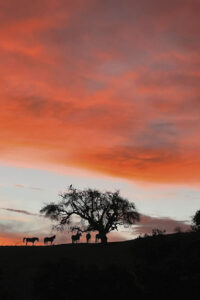
These fossil remains are genetically different than modern mustangs, which most scientists believe were reintroduced to North America in the 1500s by Spanish explorers.
Many of today’s Challis bands are thought to be descendants of horses turned out by Native Americans when they were forced onto reservations, and even by ranchers, who were forced to trust the horses to nature when the Depression left them broke and unable to care for them.
Every summer in Challis, the Bureau of Land Management conducts a census from an airplane. When the herd numbers approach 253, they hold what they call a “gather,” rounding up and removing enough horses to bring the numbers down to around 185 to share 167,848 acres [EDITOR’S NOTE: Per BLM 2023 numbers for the Challis Herd Management Area].
To the observer, these roundups are dramatic and seem inhumane. The herds are chased across wide valleys, deep canyons and eventually into burlap-lined runways that funnel into metal holding pens. As individual bands of horses are pushed in, the stress and instincts cause stallions to fight, putting mares and foals in harm’s way. Some will be injured trying to escape, some will be orphaned, and possibly some will die.
At the end of the day the shaken animals are loaded into cattle trucks to be transported to a BLM facility. At the facility the horses are sorted, some are released back into the wild and some are sent off to auction. Some will be sold for $125 each. Some will spend the rest of their lives in government holding pens, others might live their lives out at sanctuaries. Still others could find their way to slaughter [EDITOR’S NOTE: The 2004 Burns Amendment to the 1971 Wild Free-Roaming Horses and Burros Act directs the BLM to sell excess (unadopted or unsold) horses “without limitation” to any willing buyer; however, the BLM Bill of Sale states that the buyer agrees not to process any of the sold horses or burros into commercial products, or to knowingly sell or transfer ownership to any person or organization whose intent is to commercially process the animals. Horse slaughterhouses were banned in the U.S. in 2007 but still operate in Canada and Mexico.].
– Bonnie Garman, 2007
Nearly 2 million wild horses once roamed the American West as recently as the 1800s. However, the encroachment of man and competition for rangeland has chipped their existence down to an estimated 82,000 wild horses today.
Integral to the history of the American West and the westward expansion of the country, the horse has always been a symbol of the American ideals of freedom, grit, loyalty and strength. And it is these virtues that drew Kline to the Challis band she first photographed in 2004. Her reflections on the parallels of their shared journey over the past two decades are captured here in words and images that chronicle resilience through trauma and adversity, joy and connection:
When I first met these horses, I was living on a ranch in a wilderness area with my (then) husband and nine-year-old son. I would sometimes drop him off at the school bus, on its way to Stanley then drive the back roads in search of horses for a few hours before picking him up at the bus. The hours I spent alone with the horses on their home range in Challis were some of the highlights of my life.
The memory of their wild, untamed beauty etched itself into my soul, compelling me to capture their essence through the lens of my camera in hopes I could bring attention to their plight. Little did I know that this encounter would mark the beginning of an extraordinary bond that would shape my life in ways I never imagined.
As the years unfolded, I found myself drawn back to the Challis herd, each encounter deepening my connection to these magnificent creatures. The years that followed were filled with both triumphs and trials, none more profound than the 2009 round-up, a stark reminder of the fragility of their existence.
In the wake of the round-up, I found myself propelled into action, driven by a desire to make a difference. After a talk at The Community Library with Deeann Stillman, author of “Mustang,” we shared their story with the world. This helped inspire local action that led to the adoption of 21 mare with the help of Valley locals Jodi Herlich and Doro Lohman of Silent Voices Equine Rescue.
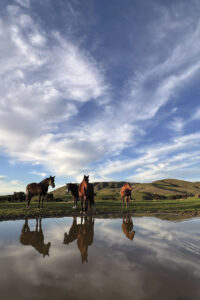
Genetic analysis has shown that the horse family lineage in North America dates back nearly 60 million years. Fossil remains have been collected at the Hagerman Fossil Beds National Monument, about 90 miles from Ketchum, where a skeleton of the Hagerman Horse can be seen.
The years following the initial adoption were uncertain for the horses, but amidst the challenges, there were moments of joy and connection. Spring brought new life with the arrival of foals, and the resonance of Idaho’s wild horses found its way to the global stage, featured in Carole King and James Taylor’s “Troubadour Reunion” world tour. The horses’ plight was helped by the generosity of others through fundraisers and exhibitions featuring their images printed on life size fabric and highlighting family bonds.
Shortly after the 2009 round-up, my family moved to Santa Cruz, Ca. A couple of years later, the Challis Rescue Horses were moved to the first of two California sanctuaries, a bittersweet transition from their native landscapes to a new home. I remember sitting on the hillside the night they arrived at Return to Freedom and saying out loud to a mare I’d known in the wild, “I’m not sure what we’re doing here, but at least we’re safe”
These horses were not a family band until the day they were rounded up. In an instant, they lost their freedom, their land and their original family bands. In time, they regrouped and became a family. I too have lost my original family, and I am in the process of regrouping. Their example of grace under pressure, resilience and loyalty inspires me as I find my own next chapter.
It has now been 15 years since their rescue. Far from their Idaho homeland, and amidst tremendous change, the horses have remained standfast, forming bands and adapting to their new surroundings. The older (gelded) stallion, Nelson, leads a separate group of mares, a testament to the bonds forged over time. Despite their freedom being restricted, they communicate with grace, living alongside other bands while maintaining their unity.
We are all getting older. The once vibrant brown mares have turned gray, echoing the passage of time. The dapple grays have turned white and adopted a white filly who lost her mother during one of the moves. She is always with them, perhaps because they are similar in color to the mother she lost. Three of the brown mares have been together since the beginning and never leave each other’s sides.
Some of the feisty ones who would buck and kick are content to stand around and close their eyes as the sun hits the land. Despite having thousands of acres to roam, and hundreds of other horses, the herd stays together. Moving in the same small groups, but always within proximity of the other horses from Challis.
Some of them are moving slower but they can all still run and navigate the hills with ease. All of them are more relaxed, and I feel a sense of peace and contentment, knowing that their needs to roam freely are met now that they are safe on thousands of acres at Freedom Reign Equine Sanctuary in Central California, after making the move from Return to Freedom in 2015, hopefully the last move of their long journey from their Challis homeland.
– Elissa Kline, 2024
The story of the Challis Wild Horses is not just one of survival but of resilience, unity, and the enduring spirit of freedom. In their journey, we find echoes of our own struggles and triumphs, reminding us that even in the face of adversity, there is hope and beauty in the bonds that unite us.

